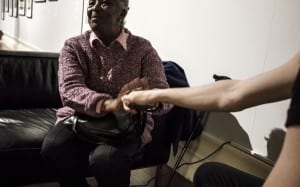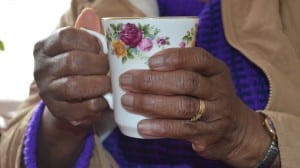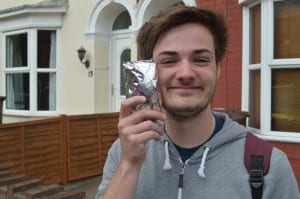COMMUNITEA
Framing Statement
“In nothing is the English genius for domesticity more notably declared than in the institution of this festival—almost one may call it so—of afternoon tea. Beneath simple roofs, the hour of tea has something in it of sacred; for it marks the end of domestic work and worry, the beginning of restful, sociable evening. The mere chink of cups and saucers tunes the mind to happy repose.” (Gissing, 2005, EBook).
Our main interest lay in connecting people, creating a sense of informality, generating laughter and conversation. We set out to explore the peculiarities of Lincoln’s community. Is there a distinct quality or flavour of Lincoln that separates it from the rest? What does the average member of its community have to say? What is their story? Taking inspiration from Rimini Protokoll’s 100% City, we recognised that “for statistical purposes, people are regularly converted into pie wedges, bars and curves – which are then used to make political arguments or to create economic cost-benefit strategies. What if these statistics were given faces?”, or in our case voices? (Rimini Protokoll, 2014).
Taking influence from The Usher Gallery’s display of tea related porcelain in gallery three, we pondered upon what tea represents. We came to the conclusion that, while holding a level of uniqueness for each individual, it often symbolises a moment of peace and serenity, a coming-together, and a preparation for a new day- a new beginning.
Everyone has a level of individuality when it comes to tea: their tea-making process; the memories the beverage elicits; the connotations they project onto it; and lastly, how they take it. All this being so, we saw that the end of communion in today’s society can be achieved by the same means: a cup of tea.
Utilising a ‘good old fashioned cuppa’ as an instrument of rapport, we knocked on doors, sat down with the people of Lincoln in their own homes, and had a conversation with them, delving into their opinions, personalities, and habits via the topic of tea. On March 16th we set out to interview 100 people, ensuring a diverse sample. Those interviewed were invited to the gallery on May 9th to share a further cup of tea with us – bringing the process full circle. We collected the audio from the interviews as well as pictures of the participants’ hands around their cups. We compiled this, along with footage of the tea making process into a short film. Likening the community of Lincoln to a piece of art, the results were projected onto the wall of gallery three in the Usher Gallery on the 9th of May, where museum-goers who viewed the video were invited to ‘a cup of tea and a chat’ with us.
We knocked on 218 doors. 169 doors opened. 154 rejected us. 15 welcomed us. 24 people were interviewed. All about tea.
Analysis of Process
Ephemeral Art. February 17th.
The notion of performance as momentary is one that our tutor, Aylwyn, discussed in the seminar. Her delivery of The Many Headed Monster by Joshua Sofaer made me aware of something that I had previously not considered (Sofaer, 2015, lecture). I realised the importance of the audience’s impressions of the work: Pre-performance. One work cited was Kidnap by Blast Theory, a work where advertisements were shown, and the participants, having a full understanding of the work, chose whether to take part (Blast Theory, 1998). It was their choice, and their signing of the disclaimer held them to their decision. Blast Theory’s calculated decision to have an informed participant is a significant one, as the lecture noted that the participant’s knowledge changes the psychology of the performance; the subject is no longer a passive spectator, but rather an active participant.
“Our impression of the work becomes the work itself” (Sofaer, 2015, lecture)
Even more so than pre-performance, I was drawn to the idea of performance itself being ephemeral. Marina Abramovic and Ulay’s Imponderabilia typifies this notion (Abramovic and Ulay, 1977). The immediacy of the performance was something I never considered prior. It happens in a moment, with no expectations. It is a surprise for the participant, so surprising in fact that their participation in the piece borders on the subconscious. The choice of which naked figure they face has no time to be premeditated. This spontaneity is an area I find compelling, a territory of art that has much to offer.
Site Dictates Performance: Thoughts on Ergonomics. February 18th.
In Site-Specific Performance, Pearson puts forth the idea that “the engagement of the performer at site is in essence ergonomic” (Pearson, 2010, 171). In The Oxford Dictionary and Thesaurus, ergonomics is defined as “the study of the efficiency of persons in their working environment” (Tulloch, 1997, 499). An ergonomically charged working environment would be one that maximises all aspects of performance, readiness, and proficiency while minimising threats, restrictions, and limitations. In a normal working environment this is simple; elements of the space are coordinated in a way to achieve efficiency, whereas performance in a specified site contests this notion. The site cannot be ergonomically charged as altering the site’s components refines its essence. It is already apparent that by the very nature of site-specific performance, “to move the … work is to re-place it, to make it something else” (Kaye, 2000, 2). This therefore applies to the site itself as if it is no longer in its original form the meaning of the site is distorted and by default so is the performance.
This is a concept which has revealed to me the importance of considering the gallery in its unaffected form. The site dictates our work, rather than our work dictating the site, as “the very engagement [with the seemingly hindering conditions] may form the substance of performance: ergonomics as performance” (Pearson, 2010, 172). The notion of site dictating our end product has left me to consider what my performance partner and I can utilise. We have seen many interesting stimuli that may lead us to performance: the architecture of the building, the statues in the Usher Gallery, and the contrasting darkness of the space with the porcelain tea cups in gallery three to name a few.
Performance Ideas & the Value of Art. February 25th.
Upon our first meeting this week, we had five main topics that we were interested in:
- The (in)accessibility of art for the working-class;
- Whether the pieces chosen to be displayed in museums are bias, why should x be displayed and y not?;
- Raising questions as to the value of pieces of art, an average spectator may ask why Yves Klein’s IKB 79, a canvas that seems to be simply painted blue, can stand in an art museum, whereas a detailed portrait by an amateur artist cannot (Klein, 1959)? What makes one more valuable than the other?;
- The connection of people. Relationships among communities that transcend data and statistics. Breaking down the formalities of everyday life in order to create a casual and relaxed atmosphere, enhancing potential for moments of affinity.
- The aforementioned trouble of overrepresentation of white middle-class males.
In our discussion we discussed the performance aspects we were interested in such as immediacy of art, audience participation, and the authenticity of the performance/ moment/ meaning. Something that also struck us was the purity of Abramovic’s performances. The simplicity and clarity which she shows serves to promote her original idea.
Through many more discussions we had a performance plan. We thought of separating white males from the rest of the audience and having them create a piece of art on one canvas, while anyone who was not white or male created a separate work. We were then to display these pieces in the Viewpoint gallery. The piece by the white males would be displayed with a sign exhibiting its sale for a high price while the other work would advertise a low price.
We felt that our idea incorporated all of our interests and worked well, but we lost sight of the simplicity we wanted to achieve. To us, our plan seemed clear and calculated, but we discovered obstacles in the planning of our piece: with obstacles came solutions, and with our solutions came obscurity of meaning. Now, focusing on representations in art, much the same way Rimini Protokoll’s 100% City does, we aim to show a representation of Lincoln through selecting a range of people and documenting something about them (Rimini Protokoll, 2008-2014). This is an idea that we feel can achieve Abramovic’s simplicity while not losing sight of our original aims and intentions.
A Sacred Practise. March 9th.
Our idea of portraying Lincoln’s community through art seemed like a simple idea, but we required a medium through which to show it. We discussed our troubles of finding this medium with our tutor, Aylwyn, and reached the conclusion that drinking tea is a common-place ritualistic custom that typifies the English way. Tea-drinking is a stereotype of England that most households conform to; a way of connecting individuals and a form of collaboration over a common interest. This idea of congregating via a mutual appreciation is one that we thought critical to our practise, as this assembly is synonymous with participatory performance, a typical characteristic of the module.
My performance partner Tom and I researched this area of site-specific performance and saw that Quarantine’s work was exemplary of what we wanted to achieve. Their performances Eat Eat, Coming and Going – In The Neighbourhood, and The Slightest Movement all revolved around seeing communities as collections of individuals, a field of study in which we wished to explore (Quarantine, 2003; Quarantine, 2008; Quarantine, 2008 & 2012). The medium through which this was performed was often through food, a concept of which our performance is closely tied to. The director of Eat, Eat, Renny O’Shea believes that “everyone has food to celebrate something – a birth, a death, a marriage. We have powerful memories of exquisite food, sacred food, hunger, the taste of something we didn’t want to eat, the smell of the kitchen we grew up in. We all have to eat” (O’Shea, 2004). Tom and I saw this and believed it to be pertinent to our performance. We believe that drinking tea is an experience that brings people together, it is a break from the stresses of modern-day life. It serves as a moment of calm, stillness, and tranquillity, separating one from the intensities and tensions that we experience on a daily basis. These moments of serenity are therefore “sacred” to individuals in today’s culture, binding our performance with the practises of Quarantine.
Our plan has been formed and seems simple. We drink tea with 100 strangers in Lincoln. We audio record the conversations we have with them, and we ask them a list of six questions:
- What order do you make your tea?
- How do you take your tea?
- What brand of tea do you buy?
- Invite three people alive/ dead, famous or not to drink tea with you. Who and why?
- What is the best cup of tea you have ever had?
- If you could only have three cups of tea for the rest of your life, when/ where would you have them, who with, and why?
After this, we take a picture of their hands around their cup. The audio and visuals we collect will then be installed in the Usher gallery on 9 May 2015. We invite the participants to see the installation on that date, to see the projection of the video, and then to join us for “a cup of tea and a chat”.
This performance has purity to it, as our intentions are clear. We aim to create an ephemeral experience for the participants, a sense of community, a coming together, an informal happening that highlights the conventional act of “having a cuppa”. This project will underline Lincoln’s community, accentuating its different cultures, characters, and lifestyles. The work will frame our findings as an artwork, likening the people of Lincoln to the pieces seen in the galleries, creating a sense of importance of the city’s culture, showcasing the exploration as a celebration of Lincoln’s differences and similarities alike.
Photo is my own.
Failure: An End In Its Own Right. March 20th.
On March 16th, we commenced our performance. We set out through the streets of Lincoln and knocked on 36 doors. At 11 of these doors there was no answer, whereas 25 answered. This alone seems successful, but after 22 rejections, including excuses that are dubious at best, we have realised how challenging our performance is in reality.
The fact of the matter is that we are two nineteen-year-old males, knocking on strangers’ doors, asking them to stop what they are doing, let us into their homes and make us tea. We are aware of the conjecture that this process may raise, as in England, there seems to be a growing level of scepticism and distrust of our neighbours. When looking at other practitioners of participatory performance, we knew the task in hand would be difficult. However, we saw that our task was to engage the audience of Lincoln, a quiet and relatively peaceful city in England, whereas past practitioners have had a much heftier task. We considered the Face 2 Face project in Israel and Palestine by JR and Marco. They noted that these two dangerous territories contain “mountains, sea, deserts and lakes, love and hate, hope and despair embedded together”, yet “the crazy thing is that the guys accepted” to be part of the project (JR, 2007). In comparison, our task is not to strive for change or shift the course of a civilisation, it is to simply meet people and drink tea.
Furthermore, the rejections, the excuses, and the unanswered doors are of value. We aim to explore the community of Lincoln, and each failed opportunity for an interview is a telling of the community – it represents unwillingness, isolation, and a sense of solitude that successful interviews may not possess. This is a continuation of my thoughts on ergonomics. The restrictions, difficulties, and limitations of performance must not be resisted, but rather embraced. The struggle against these factors is performative. The endeavour to create a piece lends itself to the end product. That which hinders us can be shaped into performance itself.
Ms Cottrington. April 21st.
Despite our difficulties in engaging participants, our determination has not been hindered. Since our first endeavour, the statistics of our outings are as follows:
- Doors Knocked On: 180
- Doors Unanswered:46
- Doors Opened: 134
- Doors Rejected: 121
- Doors Where We Were Welcomed: 13
- Interviews: 22
We are now more confident in our interviews and outer initial meetings with strangers. We were aware that Quarantine’s participatory processes are “lengthy and discursive, a mix of rigorous practice, seemingly aimless conversation and moments that somehow stick, apparently discovered by accident”, but we were unaware how much this would apply to our practise (Quarantine, 2015). On April 19th, we had a widely successful day, 29.41% of the doors we knocked on welcomed us in.
In the course of the day we met an extremely influential character, Yvonne Cottrington. Yvonne hailed from Guyana and was a retired nurse of 83. She provided us with the most welcoming air we have experienced and gave us an interview that was nothing short of compelling. She lived alone and was truly intrigued by our stories and our performance. She spoke extensively with us about her upbringing and her children, her faith and her outlook, and not to mention, her views on tea.
She was so welcoming that we stayed at her house for a substantial amount of time and she refused to let us leave empty-handed. We were given a packet of tea bags by her, and to repay her generosity we will arrange transport for her to the gallery. To bring the performance full circle, once she has viewed the video, we will use the tea bags she has gifted us to show our appreciation of her gesture.
Picture is my own.
Performance Evaluation
 Photo credit: Fenia Kotsopoulou
Photo credit: Fenia Kotsopoulou
During our performance on May 9th, my performance partner and I sat around a small, picturesque table that faced the projection of our video and evoked a welcoming environment for museum-goers. We offered them a seat and introduced ourselves before introducing our looping video, at which point they were free to talk with us, or to simply sit and watch the projection. After a period of time, we offered them to go upstairs with one of us to have ‘a cup of tea and a chat.’ Many concurred, and all participants produced refreshing conversation.
The experiences we had with the strangers were testament to our goal of bringing people together, and exploring the community of Lincoln.
 Photo credit: Fenia Kotsopoulou
Photo credit: Fenia Kotsopoulou
Through continued interaction with Ms Cottrington, we had arranged a taxi for her which arrived at the Usher Gallery. She viewed the video and exclaimed with joy upon seeing her hands and hearing her voice within the museum. We made her tea with the tea bags she gifted us and talked about our performance, her background, and the group’s experiences with tea. Her contribution to our performance is priceless. We have arranged continued interaction with her and our communication with Yvonne will continue for the foreseeable future. She is a prime example of unheard voices, and the experience with her can now be cherished through our performance and documentation of process.
Our final performance was hugely successful. We engaged the public and had conversations about tea, history, and went as far as commenting on humanity. We achieved our aim and established a sense of community.
If the performance was conducted again, we would consider the difficulties of when too many people were in the room. Often the gallery felt clustered, and when certain spectators desired our total attention, others may have felt alienated by the experience due to our lack of interaction with them.
The documentation of such an experience is one that I would never consider in a traditional theatrical environment. My study of site-specific performance has truly converted my outlook on performance. Prior to our project I would have believed that the interviews and pictures were a means to the performance’s end. However I now see that the documentation of a process is as important – if not more so- than the final product. Abolishing the proscenium stage and engaging within a site has led my performance partner and I into a realm of performance that neither of us experienced. The voices of those we encountered would not have been heard, the stories would not have been told to the audience they were, and a lot less tea would have been drunk.
Our project boasted a simple aim through a simple means of a simple pleasure. A community connected by tea. The drinking of tea dramatized into a positive experience for all involved. A sample of Lincoln was explored and the results were celebrated. Friendships were made and our performance introduced us to characters we would unlikely socialise with. It brought us together in the English way.
Our final results are as follows:
- Knocked on: 218
- Doors not answered: 49
- Doors opened: 169
- Doors rejected: 154
- Doors where we were welcomed: 15
- People interviewed: 24
3,192
Works Cited:
Abramovic, M, and Ulay. (1977) Imponderabilia. [performance art] Bologna, Italy: Galleria Communale d’Arte Moderna.
Blast Theory (1998) Kidnap. [performance art] England and Wales, 15 May – 17 July.
JR (2007) Face 2 Face. [performance online] Various Locations: Israel & Palestine. Available from http://www.jr-art.net/projects/face-2-face [Accessed 12 March 2015].
Kaye, N. (2000) Site-Specific Art: Performance, Place and Documentation. Oxon: Routledge.
Klein, Y. (1959) IKB 79. [paint on canvas on plywood] Lincoln: The Collection (loan).
O’Shea, R. (2004) Eat, Eat. [online] Quarantine. Available from: http://qtine.com/work/eat-eat/ [Accessed 4 March 2015].
Pearson, M. (2010) Site-Specific Performance. Basingstoke: Palgrave Macmillan.
Quarantine. (2003) Eat Eat. [performance art] Leicester, England: Leicester Haymarket Theatre, June.
Quarantine. (2008) Coming And Going: In The Neighbourhood. [performance art] Liverpool, England, November.
Quarantine. (2008 & 2012) The Slightest Movement. [performance art] Manchester, Aberystwyth, London, Dublin, Falmouth: UK.
Quarantine (2015) How We Work. [online] Manchester. Available from http://qtine.com/about-us/how-we-work/ [Accessed 4 March 2015].
Rimini Protokoll. (2008-2014) 100% City. [performance art] Various places and dates.
Sofaer, J. by Walsh, A. (2015) The Many Headed Monster. [lecture] Site Specific Performance DRA2035M-1415, University of Lincoln, 4 February.
Tulloch, S. (ed.) (1997) The Oxford Dictionary and Thesaurus. 3rd edition. Oxford: Oxford University Press.



Recent Comments